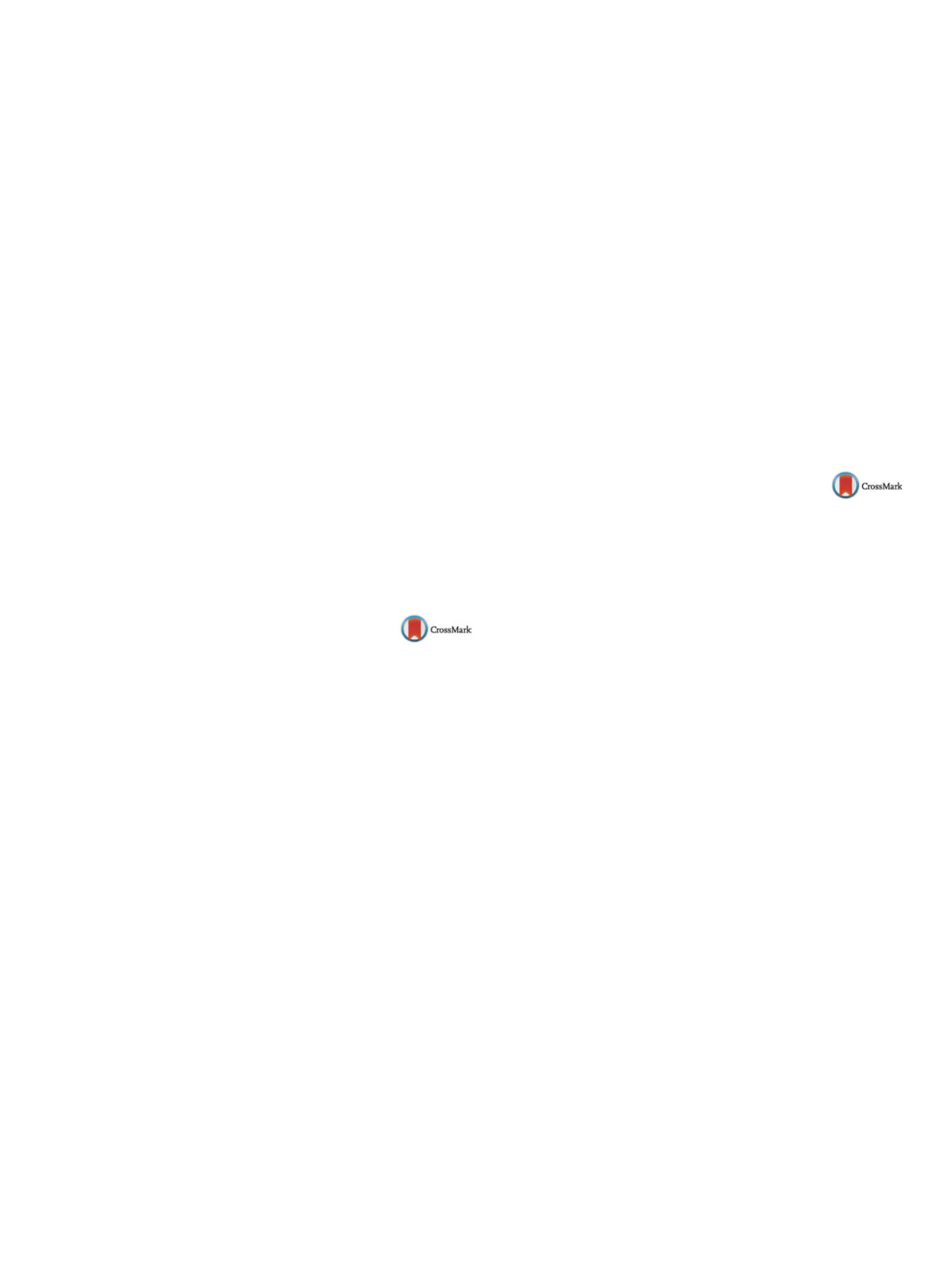

25th European congress of psychiatry / European Psychiatry 41S (2017) S365–S404
S367
Objective
Investigate relationships between clinical efficacy and
genetic polymorphims of long-acting drugs’ pharmacodynamic tar-
gets.
Methods
Seventy-eight psychotic patients, treated with atypi-
cal long-acting antipsychotics (olanzapine pamoate, paliperidone
palmitate, risperidon and aripiprazole), were examined. We carried
out a blood sampling to evaluate dopaminergic DRD2 and gluta-
matergic GRM3 genetic receptors polymorphisms. PANSS and BPRS
scales were used to assess clinical condition.
Results
Regarding the
GRM3
genes, the study of rs2228595 and
rs6465084 polymorphisms showed a prevalence of wild type geno-
typic frequency of 81.2% and 56.2%, respectively. The prevalence
of the patients with mutated heterozygote genotype (rs6465084
polymorphisms) resulted high (40.6%). Considering rs1989796 e
rs274622 polymorphisms, the sample showed a prevalence of
mutated heterozygote genotype in the 53.1% e 45.3%, respec-
tively, with a percentage of 43.7% of patients with a mutation
in homozygosis. Considering the rs146812 polymorphism, the
53.1% of patients resulted with a wild type genotype. Finally, find-
ings showed a prevalence of 56.2% for the mutated heterozygote
genotype in theDRD2 rs6277polymorphism. The genotypic catego-
rization analysis demonstrated a significative association between
the GRM3 rs274622 polymorphism and higher BPRS scores.
Conclusions
The relationship between rs274622 polymorphism
and worse clinical conditions could indicate a major resistance to
long-acting antipsychotics in patients with genotypic frequency CT
(mutated heterozygosis) for this polymorphism.
Disclosure of interest
The authors have not supplied their decla-
ration of competing interest.
http://dx.doi.org/10.1016/j.eurpsy.2017.02.370EW0757
Prescribing patterns of psychiatric
drugs in major depressive
disorder – Findings from a large
European multicenter, cross-sectional
study
M. Dold
1 ,∗
, A . Kautzky
1 , L. Bartova
1 , U.Rabl
1 , D.Souery
2 ,J. Mendlewicz
3, A. Serretti
4, S. Porcelli
4, J. Zohar
5,
S. Montgomery
6, S. Kasper
11
Medical University of Vienna, Department of Psychiatry and
Psychotherapy, Vienna, Austria
2
Université Libre de Bruxelles, Psy Pluriel Centre Européen de
Psychologie Médicale, Bruxelles, Belgium
3
Free University of Brussels, School of Medicine, Bruxelles, Belgium
4
University of Bologna, Department of Biomedical and NeuroMotor
Sciences, Bologna, Italy
5
Chaim Sheba Medical Center, Psychiatric Division, Tel Hashomer,
Israel
6
University of London, Imperial College, London, United Kingdom
∗
Corresponding author.
Introduction
The multicenter, cross-sectional survey summa-
rizes the current prescription patterns of psychopharmacological
medications in patients with major depressive disorder (MDD)
treated in European university psychiatric centers.
Methods
The study included a total of 1181 MDD patients who
were recruited in 9 academic sites across 8 European countries.
Socio-demographic, clinical, and psychopharmacological charac-
teristics were collected within a detailed clinical interview and the
current depressive symptom severity was measured by the Mont-
gomery and Åsberg Depression Rating Scale (MADRS). Symptom
reduction during the present MDD episode was analyzed by calcu-
lating retrospective MADRS scores. Descriptive statistics, analyses
of variance (ANOVAs), and Spearman correlation analyses were
performed to examine the impact of various features on the applied
pharmacological strategies.
Results
Regarding first-line antidepressant medication, the most
frequently prescribed drug classes were selective serotonin reup-
take inhibitors (SSRIs) (53.4%), serotonin-norepinephrine reuptake
inhibitors (SNRIs) (23.6%), noradrenergic and specific serotoner-
gic antidepressants (NaSSAs) (8.2%), tricyclic antidepressants (TCA)
(5.1%), and the melatonergic antidepressant agomelatine (5.0%).
Themost commonly used individual antidepressantswere escitalo-
pram (18.4%), venlafaxine (15.2%), sertraline (12.9%), paroxetine
(9.1%), mirtazapine (8.2%), duloxetine (7.0%), and fluoxetine (6.5%).
Among the patients, 59.4% were treated with polypsychophar-
maceutical medications (mean: 2 drugs) and for the number
of individual drugs, we found a significant correlation with the
present MADRS total score and the MADRS total score change dur-
ing the current depressive episode.
Conclusion
Consistent with surveys investigating primarily
municipal psychiatric treatment centers, we could replicate the
observation that SSRIs are the most commonly used antidepres-
sants in MDD for the first time for European university centers.
Disclosure of interest
The authors have not supplied their decla-
ration of competing interest.
http://dx.doi.org/10.1016/j.eurpsy.2017.02.371EW0758
The regulation of orexins and their
cognate receptors in two distinct rat
models of depression and effects of
treatments
A.J. Harpøth
∗
, B. Elfving , O. Wiborg , G. Wegener , H.K. Müller
Aarhus University Hospital, Translational Neuropsychiatry Unit,
Institute of Clinical Medicine, Risskov, Denmark
∗
Corresponding author.
Introduction
Depression has sleep disturbances as a key symp-
tom and recently sleep has been suggested as a new area to
optimize treatment in depression. Orexin is produced in the
hypothalamus and projected throughout the brain innervating a
number of structures important in depression. It controls a num-
ber of physiological processes including sleep, arousal, cognitive
processes and stress, which are affected during depression.
Objective
The study examines the possible implications for
abnormalities in the orexinergic system in depression. We aim
to determine whether treatment targeting this system relieves
depressive symptoms.
Methods
Using real-time qPCR and Western blotting optimal
sampling time is determined by an assessment of the diurnal
variation of orexin expression. Expression of orexin and its recep-
tors are investigated in the hypothalamus, the hippocampus, and
the prefrontal cortex of the Flinders Sensitive Line (FSL) and the
Chronic Mild Stress model of depression. Behavioral and molecu-
lar response to treatment with a conventional antidepressant and
an orexin receptor antagonist will be addressed in FSL rats. In addi-
tion, wewill include exercise as a noninvasive treatment, which has
shown positive effects on both sleep and depression in humans.
Results
Real-time qPCR analysis showed increased expression of
the orexin-1 receptor (40%) and the orexin-2 receptor (39%) in
the prefrontal cortex of FSL rats compared to the control rats, the
Flinders Resistant Line rats.
Conclusion
This study may provide a platform for screening of
drugs with effects on both sleep and depressive symptoms with
perspectives for the development of novel strategies for treatment
of depression.
Disclosure of interest
The authors have not supplied their decla-
ration of competing interest.
http://dx.doi.org/10.1016/j.eurpsy.2017.02.372

















